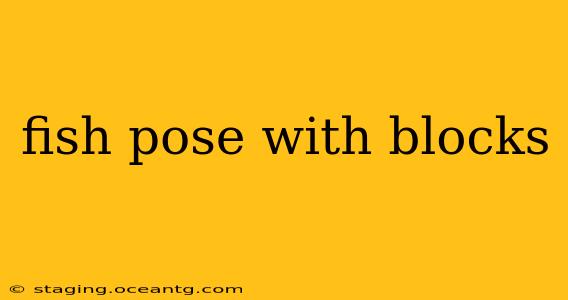The Fish Pose, or Matsyasana, is a beautiful backbend that opens the chest, shoulders, and throat. Adding blocks can significantly enhance this asana, making it accessible to a wider range of practitioners and deepening the benefits for experienced yogis. This guide explores the nuances of Fish Pose with blocks, addressing common questions and offering modifications for various body types and levels.
What are the benefits of Fish Pose with blocks?
Using blocks in Fish Pose offers several key advantages:
- Increased Accessibility: For those with limited spinal flexibility or tight shoulders, blocks provide support, allowing them to experience the backbend without overstretching or straining. Placing a block under the upper back allows for a gentler, more supported opening.
- Deepened Chest Opening: By elevating the chest, blocks can facilitate a deeper opening across the anterior chest, improving posture and breathing capacity.
- Enhanced Spinal Extension: The support offered by the blocks allows for a more pronounced and comfortable extension of the spine, promoting better spinal alignment and flexibility.
- Reduced Strain on the Neck: By supporting the back and shoulders, blocks can alleviate pressure on the neck, a common issue in traditional Fish Pose.
How to do Fish Pose with blocks?
There are several ways to incorporate blocks into Fish Pose. Here's a step-by-step guide:
-
Begin lying on your back: Lie on your back with your knees bent and feet flat on the floor.
-
Place the block(s): Place one or two blocks under your upper back, adjusting the height to suit your flexibility. A higher block placement offers less of a backbend, while a lower placement allows for a deeper stretch. You can also place the blocks lengthwise under your shoulder blades or widthwise, under your thoracic spine. Experiment to find what feels best.
-
Lift your chest: Gently lift your chest off the mat, pressing into your hands or arms to support the lift. Keep your shoulders relaxed and avoid straining your neck.
-
Gently arch your back: Allow your chest to lift and your shoulders to gently relax, creating a gentle backbend. Avoid forcing the stretch.
-
Hold and breathe: Hold the pose for 30 seconds to one minute, breathing deeply and evenly. Feel the expansion in your chest and the gentle opening in your spine.
-
Release: Gently release the pose, lowering your chest back down to the mat. Take a few moments to rest in Savasana before moving on to another posture.
What are the common mistakes to avoid in Fish Pose with blocks?
Several common mistakes can hinder the benefits of Fish Pose, especially when using blocks:
- Forcing the pose: Avoid pushing yourself too hard. The blocks should assist, not force, the backbend.
- Neck strain: Keep your neck relaxed and avoid craning it upward. Focus on gently lifting your chest.
- Improper block placement: Experiment with different heights and placements to find the most comfortable and supportive position.
- Ignoring your body: Listen to your body and stop if you experience pain.
What modifications are available for Fish Pose with blocks?
For individuals with limited flexibility or specific physical limitations, several modifications can make Fish Pose more accessible:
- Using a rolled-up blanket: If blocks aren't available or feel too firm, a rolled-up blanket can offer a gentler support under your upper back.
- Elevated legs: Keeping your knees bent and feet flat on the floor reduces the intensity of the backbend.
- Supported head: For neck discomfort, place a folded blanket or pillow under your head for additional support.
Is Fish Pose with blocks safe for everyone?
While generally safe, Fish Pose with blocks is not recommended for individuals with certain conditions, such as:
- Neck injuries: Individuals with neck injuries or pain should consult with a healthcare professional before attempting this pose.
- Severe back problems: Those with severe back issues should avoid this pose without guidance from a qualified yoga instructor.
- High blood pressure: Individuals with high blood pressure may need to modify the pose or avoid it altogether.
By understanding the proper technique, modifications, and potential limitations, you can safely and effectively incorporate Fish Pose with blocks into your yoga practice to reap its numerous benefits. Remember to always listen to your body and consult a healthcare professional or experienced yoga instructor if you have any concerns.
